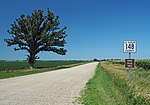Cordova, Minnesota
1857 establishments in Minnesota TerritoryFormer municipalities in MinnesotaMinnesota geography stubsPopulated places established in 1857Unincorporated communities in Le Sueur County, Minnesota ... and 2 more
Unincorporated communities in MinnesotaUse mdy dates from July 2023
Cordova is an unincorporated community in Cordova Township, Le Sueur County, Minnesota, United States. The community is located along Le Sueur County Road 2, near its junction with Le Sueur County Road 5 at Gorman Lake. County Roads 7 and 11 are also in the immediate area. The Little Cannon River is nearby. Cordova had a post office from 1857 to 1907. It was platted on September 28, 1867, and incorporated on February 27, 1878, but has since returned to being an unincorporated community within Cordova Township. Nearby places include Le Center, Waterville, Kilkenny, Montgomery, Lexington, Cleveland, and Elysian.
Excerpt from the Wikipedia article Cordova, Minnesota (License: CC BY-SA 3.0, Authors).Cordova, Minnesota
209th Avenue,
Geographical coordinates (GPS) Address Nearby Places Show on map
Geographical coordinates (GPS)
| Latitude | Longitude |
|---|---|
| N 44.336388888889 ° | E -93.671666666667 ° |
Address
209th Avenue 42301
56057
Minnesota, United States
Open on Google Maps


